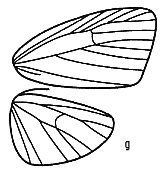|
Aemene
Walker Gen. rev.
Type species: taprobanis
Walker, Sri Lanka.
Synonyms:
Autoceras Felder (type species grammophora
Felder, Sri Lanka = taprobanis);
Hyposiccia Hampson (type species amnaea
Swinhoe, Assam), syn. n.; Panassa Walker (type species cingalesa
Walker, Sri Lanka = taprobanis);
Parasiccia Hampson (type species maculifascia
Moore, India) syn. n.
Species
in this genus have forewings with white or grey ground crossed by numerous dark,
punctate fasciae, including particularly a double postmedial one that
circumnavigates the more distal black discal dot; there is usually a second dot
more basally in the cell. There are also straighter subbasal, antemedial and
submarginal fasciae. The genus-group names brought into synonymy share
distinctive genitalic features but vary in wing venation. These genitalic
features distinguish all from typical Siccia
Walker (type species caffra Walker,
Southern Africa). All forewing veins are present, the radial sector with a
branching system ((R3, R4) R5) in Hyposiccia
and Parasiccia and (R3 (R4, R5))
in typical Aemene from the costal
angle of the cell (Fig 4g). R1 can anastomose with Sc (typical Hyposiccia)
or remain independent (Aemene,
Parasiccia). In the hindwing, M2 is lost in Aemene
but is present in the type species of Hyposiccia
and Parasiccia. The male antennae
can be bipectinate, serrate or ciliate.

Fig 4g: Aemene
taprobanis Walker
Type species: taprobanis Walker,
Sri Lanka.
The
male genitalia have a slender suprascaphial sclerotisation that is as long as
the slender uncus and apically slightly rugose. The lateral parts of the tegumen
and vinculum join conspicuously in the same twisted, lateral manner as in the Garudinia
group of genera and Macaduma and
allies. The valves have a saccular process and often a spine or spines from the
costal margin, sometimes towards the valve apex. The aedeagus vesica is globular
or bilobed, and bears a variety of scobination or spining.
The
female genitalia have conspicuous, pocket-like structures flanking the ostium
(Fig 336; maculifascia). The ductus is
short, the bursa rather elongate, pyriform, sometimes centrally constricted,
with two scobinate signa in the distal part; the ductus seminalis arises from
the junction of the bursa with the ductus. There is a corethrogyne.

The
genus is entirely Oriental, most diverse in the Himalaya and China, and
extending north into temperate latitudes. Possibly some more current Siccia
species will prove to belong here too on genitalic characters, but the
forewing in Siccia has branching (R3 (R4, R5)), and vein M2 is absent from the
hindwing as in typical Aemene. The
genitalic features are also different, though the scaphial structure and, to a
much lesser extent, the vinculum loop are present; there is general spining in
the female, rather than a pair of signa.
A.
taprobanis was
reared from larvae and pupae found on a wall in N. India by Sevastopulo (1947).
The larval head is small, black, the body grey, T1 with a transverse blackish
stripe anteriorly. There are pale grey dorsal blotches on A1, A3, A4, A6 and A7,
and a transverse stripe of the same colour on A9. There are short whitish setae
on olive verrucae (or possibly pinacula, given the tribal character).
Pupation
was in a slight web of white silk within a depression in the wall. The pupa is
brown, the abdomen ringed and the wing cases veined with black. The cremaster is
an elongate spine with two hooks, surrounded by shorter hooked spines.
The
food was presumed to be lichens growing on the wall.
Issiki
et al. (1965) illustrated the larva of
the Japanese A. altaica Lederer. It
appears bluish black with sparse black setae, a dull orange, broken dorsal
stripe and further arcuate marks of the same colour lateral to it on each
segment. The host was a foliose liverwort.
<<Back
>>Forward <<Return
to Contents page
|


